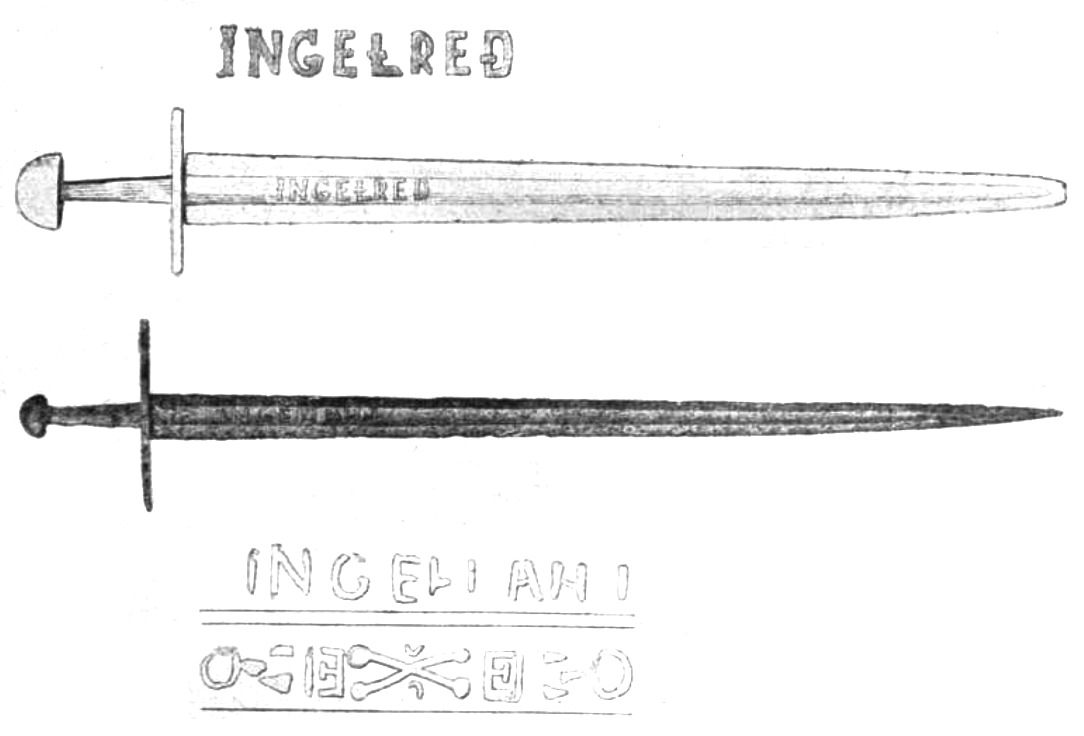Ingelrii on:
[Wikipedia]
[Google]
[Amazon]
 The Ingelrii group consists of about 20 known
The Ingelrii group consists of about 20 known
''The Sword in Anglo-Saxon England: Its Archaeology and Literature'', p. xviii–xx. Boydell & Brewer Ltd.
. Retrieved 27 September 2013. * Lower Saxony State Museum, Hanover Oakeshott, Ewart (2012
''The Sword in the Age of Chivalry'', p. 82. Boydell Press.
/ref> *Bonhams Auction 20801 Lot 188
/ref>
 The Ingelrii group consists of about 20 known
The Ingelrii group consists of about 20 known medieval
In the history of Europe, the Middle Ages or medieval period lasted approximately from the late 5th to the late 15th centuries, similar to the post-classical period of global history. It began with the fall of the Western Roman Empire ...
swords from the 10th to 12th century with a damascening
Damascening is the art of inlaying different metals into one another—typically, gold or silver into a darkly oxidized steel background—to produce intricate patterns similar to niello. The English term comes from a perceived resemblance to th ...
blade inscription INGELRII, appearing with several slight spelling variations such as INGELRD and INGELRILT. It is comparable to the older, much better-documented ''Ulfberht
The Ulfberht swords are a group of about 170 medieval swords found primarily in Northern Europe, dated to the 9th to 11th centuries, with blades inlaid with the inscription ''+VLFBERH+T or +VLFBERHT+''. The word "Ulfberht" is a Frankish pers ...
'' group (9th to 11th century, about 170 known examples).
By 1951, Ewart Oakeshott
Ronald Ewart Oakeshott (25 May 1916 – 30 September 2002) was a British illustrator, collector, and amateur historian who wrote prodigiously on medieval arms and armour. He was a Fellow of the Society of Antiquaries, a Founder Member of the ...
had originally identified thirteen such swords of this inscription, and had suggested that another, at Wisbech Museum, found in the river bed of the Old Nene in 1895, is also an ''Ingelrii''; supported by Davidson as a possible fourteenth.
Other variations of the inscription have also been found: INGRLRIIMEFECIT on a sword found by Sigridsholm, Sweden, and INGELRIH FECIT on a sword found in Flemma, Norway
Norway, officially the Kingdom of Norway, is a Nordic country in Northern Europe, the mainland territory of which comprises the western and northernmost portion of the Scandinavian Peninsula. The remote Arctic island of Jan Mayen and the ...
.
Known Ingelrii swords
*British Museum
The British Museum is a public museum dedicated to human history, art and culture located in the Bloomsbury area of London. Its permanent collection of eight million works is among the largest and most comprehensive in existence. It docum ...
– ''Ingelrii'', found in the River Thames, along the King's Reach, at Temple
A temple (from the Latin ) is a building reserved for spiritual rituals and activities such as prayer and sacrifice. Religions which erect temples include Christianity (whose temples are typically called churches), Hinduism (whose temples ...
* Wisbech Museum – found at Raven's Willow, Peterborough
Peterborough () is a cathedral city in Cambridgeshire, east of England. It is the largest part of the City of Peterborough unitary authority district (which covers a larger area than Peterborough itself). It was part of Northamptonshire until ...
Davidson, Hilda Ellis (1998''The Sword in Anglo-Saxon England: Its Archaeology and Literature'', p. xviii–xx. Boydell & Brewer Ltd.
. Retrieved 27 September 2013. * Lower Saxony State Museum, Hanover Oakeshott, Ewart (2012
''The Sword in the Age of Chivalry'', p. 82. Boydell Press.
/ref> *
Bavarian National Museum
The Bavarian National Museum (german: Bayerisches Nationalmuseum, links=no) in Munich is one of the most important museums of decorative arts in Europe and one of the list of largest art museums in the world , largest art museums in Germany. ...
, Munich – found in the Danube near Hilgartsberg
*Swiss National Museum
The Swiss National Museum (german: Landesmuseum)—part of the ''Musée Suisse Group'', itself affiliated with the Federal Office of Culture, is located in the city of Zurich, Switzerland's largest city, next to the Hauptbahnhof.
The museum bu ...
, Zurich — an 11th-century sword found in Marin, Neuchatel
*Sword with +INGELRI+ inscription, and +PREBM+ on the reverse side, pommel of "tea-cosy", length 89.5 cm (blade 75 cm)
*A singular sword with a variant form of the inscription, read as +SINIGELRINIS+, dated mid-10th to mid-11th century, formerly of the Frank Unrath collection (auctioned in 2013)/ref>
See also
*Viking Age arms and armour
Knowledge about military technology of the Viking Age (late 8th to mid-11th century Europe) is based on relatively sparse archaeological finds, pictorial representation, and to some extent on the accounts in the Norse sagas and laws recorded in t ...
*Ulfberht swords
The Ulfberht swords are a group of about 170 medieval swords found primarily in Northern Europe, dated to the 9th to 11th centuries, with blades inlaid with the inscription ''+VLFBERH+T or +VLFBERHT+''. The word "Ulfberht" is a Frankish pers ...
References
*Alfred Geibig, ''Beiträge zur Morphologischen Entwicklung des Schwertes im Mittelalter'', 1991, p. 124 *Lech Marek, ''Early Medieval Swords from Central and Eastern Europe'', 2005, pp. 49–54, plates 6c and 25c Viking swords 10th-century military history {{England-hist-stub